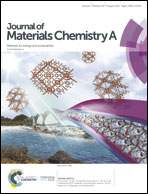Giant electrostrictive effect in lead-free barium titanate-based ceramics via A-site ion-pairs engineering†
Abstract
Electrostrictors offer unique advantages over piezoelectrics, including no poling process, temperature stability and hysteresis-free strain characteristics. Learning from the distinction between disordered and ordered ABI0.5BII0.5O3 perovskite-structured electrostrictors, the electrostrictive effect enhances with a smaller active space for B ions. Here, we propose a novel design strategy to arouse the potential capacity of electrostriction in BaTiO3-based materials by A-site Li+–Ho3+ ion-pairs engineering. In this way, limited active space for a Ti-site is expected due to the contracted oxygen octahedron around ion-pairs, resulting in smaller polarization per unit magnitude of electric field but a larger strain per unit magnitude of polarization and therefore an enhanced longitudinal electrostrictive coefficient Q33. A systematic analysis evidenced that Li+ and Ho3+ ions tend to occupy the neighboring Ba-sites in one unit cell of BaTiO3, and directly form Li+–Ho3+ ion-pairs along the [001] direction. Besides, partial fragmented domain patterns induced by local structural heterogeneity due to the involvement of ion-pairs are detected in samples with higher dopants, benefiting suppression of hysteresis in strain curves. Consequently, the (Li, Ho) co-doped BaTiO3 ceramics by A-site engineering exhibit giant Q33 up to 0.06 m4 C−2 which is superior to other lead-bearing/free electrostrictive materials, meeting the requirement of a thermal stability (20–150 °C) – low hysteresis (<10%) – large strain (0.12–0.2%) combination stimulated by the outstanding electrostrictive effect. Our research provides a new paradigm for designing applicable high-performance electrostrictive materials through A-site engineering. This is expected to benefit a wide range of functional materials.



 Please wait while we load your content...
Please wait while we load your content...